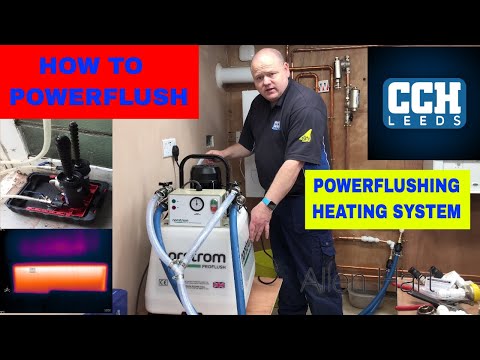HOW TO DO A POWER FLUSH Step by step guide on how to powerflush a gas combi boiler, Powerflushing a central heating system.
Today we’re gonna talk about power flushing. We are here in leeds today. Powerflushing a central heating system in Leeds So I’ve got my new power flush machine here, and we’ve got a combi boiler. So what I’m gonna do is I’m gonna do a power flush on a combi boiler system. So what we’ve done, put some tees in the pipework here, and first of all what I’m gonna do is I’m gonna connect onto these tees with the power flush machine, and then we’re gonna flush it through. We’re gonna heat the water up with a heater on it, and we’ll see how long that takes to warm up. So this is all now cold at the moment. It’s been off for a while, so I’m gonna trust that it’s cold. And then we’ll see how we go. So let’s get started.
So we’ve got a filter on this, so it’s gonna be very easy just to drain it down. So first of all we’re just gonna let all the pressure out of it. Just let that drain down there. So in normal use, if you’ve got a combi boiler and you’ve got your pipes coming down underneath your combi boiler, it may be that you want to just cut some tees into flow and return, and then that way you can just flush from that. You can also get a flushing adapter for the pump. So then you can just flush directly from the pump. So what I’ve done here, I’ve just got some push fit fittings and I’m connecting the pipes onto it. I use push fit, I use speed fit normally, because you can just take them back off afterwards and you can reuse them. So I like to use speed fit. So we’ll connect our hoses onto this now.
So as we can see there we’ve connected this flow and return with these blue hoses, and they connect onto power flush machine there. So these valves at the top we’re gonna turn off. So they would normally be for the dump, so when we’re starting to dump the water out of it. And then we’ve got our filling point there. On this I’m just gonna use boiler, so I’m just gonna use the filling loop on the boiler, just for demonstration of this. And then in there, that’s where we’d put our chemicals. We’ve plugged our pump into that one, and then we’ve plugged the heater into this one separately.
So on this it’s got a filling loop here. So all I’m gonna do for now is just by doing that, and then that’ll put water in the machine. It’ll take a while though. So when we look on machine, it’s got a minimum point and it’s got a maximum point there. And then this connection here, this is the overflow. So if it started to leak water out it’d come out of here. So obviously if you had it in the tub it comes with it’d have a flow into that, or you can connect a hose pipe to that as well. So as we can see here now, the level’s going up. I don’t know if you can just see it there. You can just see water level is going up. It’s about here now. So we’re probably gonna get about half way.
So we’ve got the water there now, just above half. And then what we’re gonna do now, I’m gonna put the heater on. We’ll see how long that takes to warm up.
So then you put your chemicals in. So you can put whatever brand of chemicals you like in. So for today we’ve got this long life sludge remover from Norstrom. So we’re gonna out that in. But you could use Fernox, you could use Sentinel or ADEY. They’re all very good for power flushing.
So just while we’re waiting for that now to warm up, so how this will work is you’ve got your flow return here, that’ll go into your central heating system. So what you can do is you can isolate underneath the boiler, and then this will go round all your heating, all your heating system. So if you’ve got ten rads for instance, then you can flush round all your ten rads. So normally what I’d do is I’d open all the radiators, so go round all your radiators in house, I’d open them all, and then I’d put your chemicals in and I’d flush it round. And then once you’ve flushed it all round you can then go do the radiators individually. So how you’d do it then is just do them one at a time. So flush one rad, go turn the next rad on, and then turn the last rad off. So you’ve just always got one rad open at the same time.
So it’s coming up a bit now, its temperature. We’re just over 20 degrees. One thing I will say is it’s always gonna be better to use the boiler if possible to get heat into the system. So if you can fire your old boiler up before, get all the heating system warm, then that would be much better and it’d make it a bit quicker. Because obviously doing it with an electric element i
So I’m not gonna connect the MagnaCleanse in on this one, but quickly I’ll just show you what I’ve done is I’ve made a male and male connection, and this side is inch and this side is three quarter. And then they will easily connect the MagnaCleanse to the power flush machine, because the hoses for the MagnaCleanse are one inch connections, and the connection for the power flushers use three
Power flush machine







